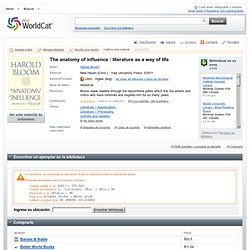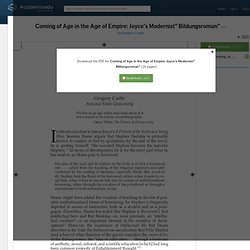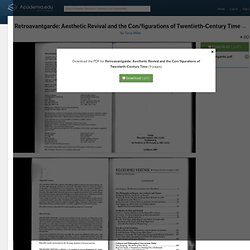

The anatomy of influence : literature as a way of life (Book, 2011. Bloom leads readers through the labyrinthine paths which link the writers and critics who have informed and inspired him for so many years.

For more than half a century, Bloom has shared his profound knowledge of the written word with students and readers. In this, his most comprehensive and accessible study of influence, Bloom leads us through the labyrinthine paths which link the writers and critics who have informed and inspired him for so many years. The result is "a critical self-portrait", a sustained meditation on a life lived with and through the great works of the Western canon: Why has influence been my lifelong obsessive concern?
Why have certain writers found me and not others? What is the end of a literary life? Harold Bloom. (1) An Other Beginning — Here Comes Everybody: The Joycean work of art against the foil of Heidegger's thinking. (1) Coming of Age in the Age of Empire: Joyce's Modernist" Bildungsroman" Humboldt defined Bildung in terms of individual autonomy and self-sufficiency.

Society, indeed life in general, as Humboldt believed, is better observed, the ideal of cultivation in some respects entailing thestatus of spectator with respect to life, one who “look[s] at the worldas a spectacle, rather than as a serious concern in which one mustactively intervene.” As Martin Swales has recently remarked, the Bildungsroman is “aneloquent starting point” for a critique of in large measure because the form “does not offer unequivocal certainties, unreflectedvalues, but embodies the difficulties of those aspirations which, intheir theoretical and discursive formulation, can be so forbiddingto English readers.” James Hardin makes a similar point about thedisparity between the and the concept of : “TheHumboldtian model of the university in particular, with its statedaim of independent learning and the development of the personality,cannot be projected back onto the idea of the Goethe’s paradigmatic form. (1) Nietzsche, Aesthetics and Modernity. Type to search for People, Research Interests and Universities Searching...

Nietzsche, Aesthetics and Modernity by Matthew Rampley Publisher: Cambridge University Press Publication Date: 2007 Research Interests: Aesthetics, Epistemology, Theodor Adorno, Friedrich Nietzsche, Modernism, and 5 moreFriedrich Schiller, Richard Wagner, Arnold Schoenberg, Stravinsky, and The Birth of Tragedy <div>(<a href=" class="research_interest_link" data-id="33398">Friedrich Schiller</a>, <a href=" class="research_interest_link" data-id="42172">Richard Wagner</a>, <a href=" class="research_interest_link" data-id="48316">Arnold Schoenberg</a>, <a href=" class="research_interest_link" data-id="48615">Stravinsky</a>, and <a href=" class="research_interest_link" data-id="877159">The Birth of Tragedy</a>)</div> edit Add File View on cambridge.org Share EditDeleteMove section cambridge.org Log In Log In with Facebook Log In with Google or or reset password Need an account?
Academia © 2014. (1) Reviving Political Aesthetics: After Duchamp, Even. Affirmations apart, divide things up into smaller pieces, and be applied to its object with intensities ranging from delicate surgical precision to eviscerating violence.

At a more hidden level, both depend crucially on their relation to the human hand for their potential to be enacted: a quite surprising implication to find in. (1) Retroavantgarde: Aesthetic Revival and the Con/figurations of Twentieth-Century Time. Download (.pdf) Share Download (.pdf)Retroavantgarde.pdf1.78 MB Loading Preview.

The Antimodernism of Joyce's Portrait of the Artist As a Young Man - Weldon Thornton. The Antimodernism of Joyce's Portrait of the Artist as a Young Man. A Portrait of the Artist as a Young Man. From Modernism Lab Essays Like T.S.

Eliot’s “Love Song of J. Alfred Prufrock,” James Joyce’s Portrait of the Artist as a Young Man (1916), though a work of youth, seems prematurely aged. Joyce treats his fictional version of his younger self with a mixture of irony and sympathy. The novel tells the story of Stephen Dedalus, a young Irishman, from earliest childhood until his decision to leave Ireland for Paris and become a writer. The early chapters of the novel chronicle Stephen’s confusions as a small boy at a strict Jesuit school; in his adolescence, he visits prostitutes and wallows in sin; later, he becomes deeply religious and considers entering the priesthood; finally, he recognizes that his destiny is to become not a Catholic priest but a writer, “a priest of eternal imagination, transmuting the daily bread of experience into the radiant body of everliving life.”
Joyce explicitly modeled his techniques on Flaubert’s.